University Food Science Project: Bread Innovation and Analysis Report
VerifiedAdded on 2022/08/31
|15
|4231
|59
Report
AI Summary
This technical report delves into the realm of bread innovation, exploring the integration of dietary fibre to enhance product characteristics. The report begins with a comprehensive literature review, examining product innovation, market information, and the challenges within the food industry. It investigates the impact of fibre inclusion on bread properties, including texture and weight, and assesses the nutritional aspects of the modified bread. The methodology section outlines the materials and methods used in the bread-making process, along with the equipment employed for analysis. The results and analysis section presents data on bread texture and weight, supported by tables and statistical analysis. The discussion section interprets the findings, compares them with existing literature, and offers a critical evaluation of the results. The report concludes with key findings and recommendations for future research and development in the field of bread innovation and dietary fibre incorporation. The report also incorporates project background, objectives, and a detailed discussion on the role of food innovators in driving innovation within the food industry.
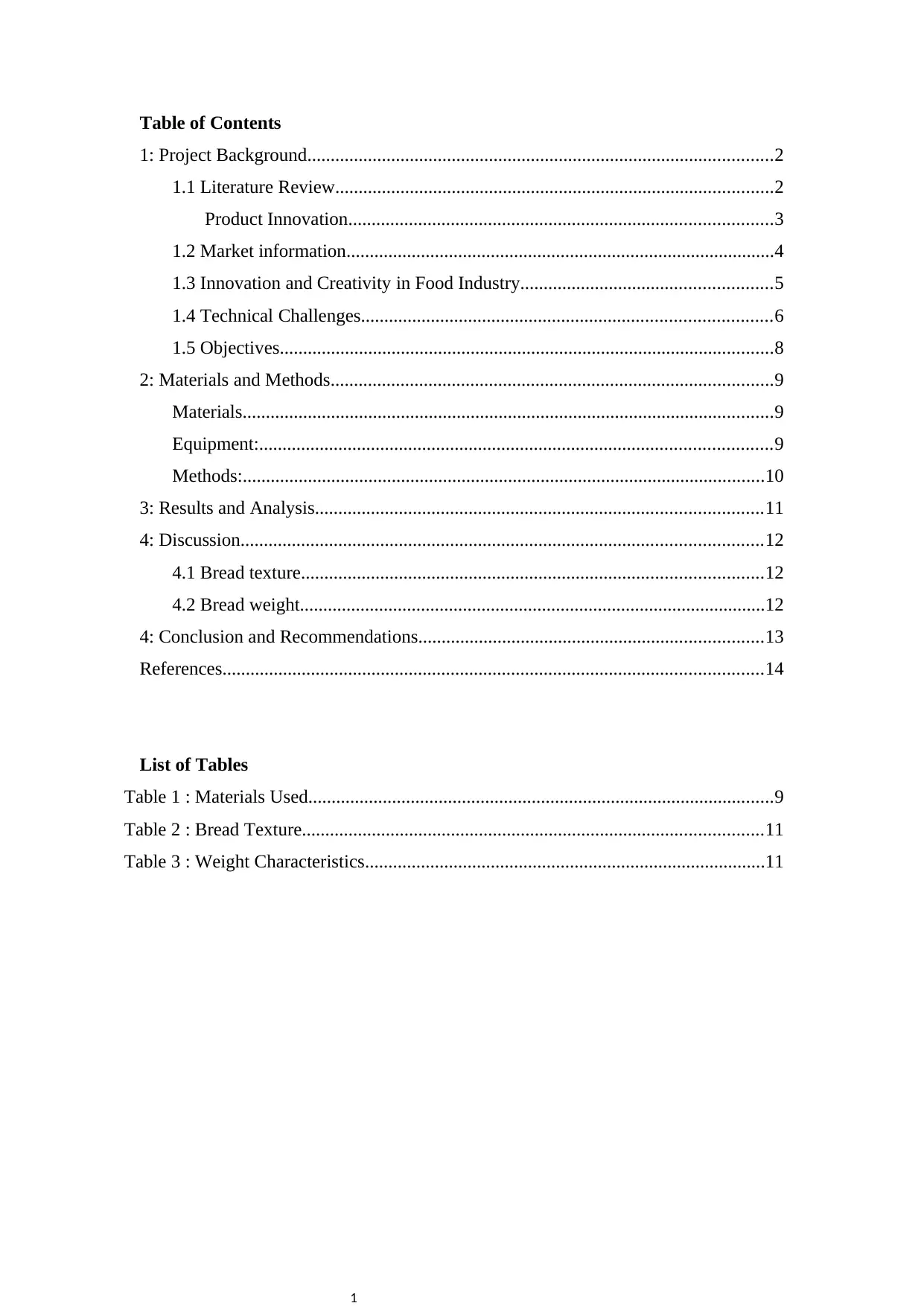
1
Table of Contents
1: Project Background....................................................................................................2
1.1 Literature Review..............................................................................................2
Product Innovation...........................................................................................3
1.2 Market information............................................................................................4
1.3 Innovation and Creativity in Food Industry......................................................5
1.4 Technical Challenges........................................................................................6
1.5 Objectives..........................................................................................................8
2: Materials and Methods...............................................................................................9
Materials..................................................................................................................9
Equipment:..............................................................................................................9
Methods:................................................................................................................10
3: Results and Analysis................................................................................................11
4: Discussion................................................................................................................12
4.1 Bread texture...................................................................................................12
4.2 Bread weight....................................................................................................12
4: Conclusion and Recommendations..........................................................................13
References....................................................................................................................14
List of Tables
Table 1 : Materials Used....................................................................................................9
Table 2 : Bread Texture...................................................................................................11
Table 3 : Weight Characteristics......................................................................................11
Table of Contents
1: Project Background....................................................................................................2
1.1 Literature Review..............................................................................................2
Product Innovation...........................................................................................3
1.2 Market information............................................................................................4
1.3 Innovation and Creativity in Food Industry......................................................5
1.4 Technical Challenges........................................................................................6
1.5 Objectives..........................................................................................................8
2: Materials and Methods...............................................................................................9
Materials..................................................................................................................9
Equipment:..............................................................................................................9
Methods:................................................................................................................10
3: Results and Analysis................................................................................................11
4: Discussion................................................................................................................12
4.1 Bread texture...................................................................................................12
4.2 Bread weight....................................................................................................12
4: Conclusion and Recommendations..........................................................................13
References....................................................................................................................14
List of Tables
Table 1 : Materials Used....................................................................................................9
Table 2 : Bread Texture...................................................................................................11
Table 3 : Weight Characteristics......................................................................................11
Paraphrase This Document
Need a fresh take? Get an instant paraphrase of this document with our AI Paraphraser
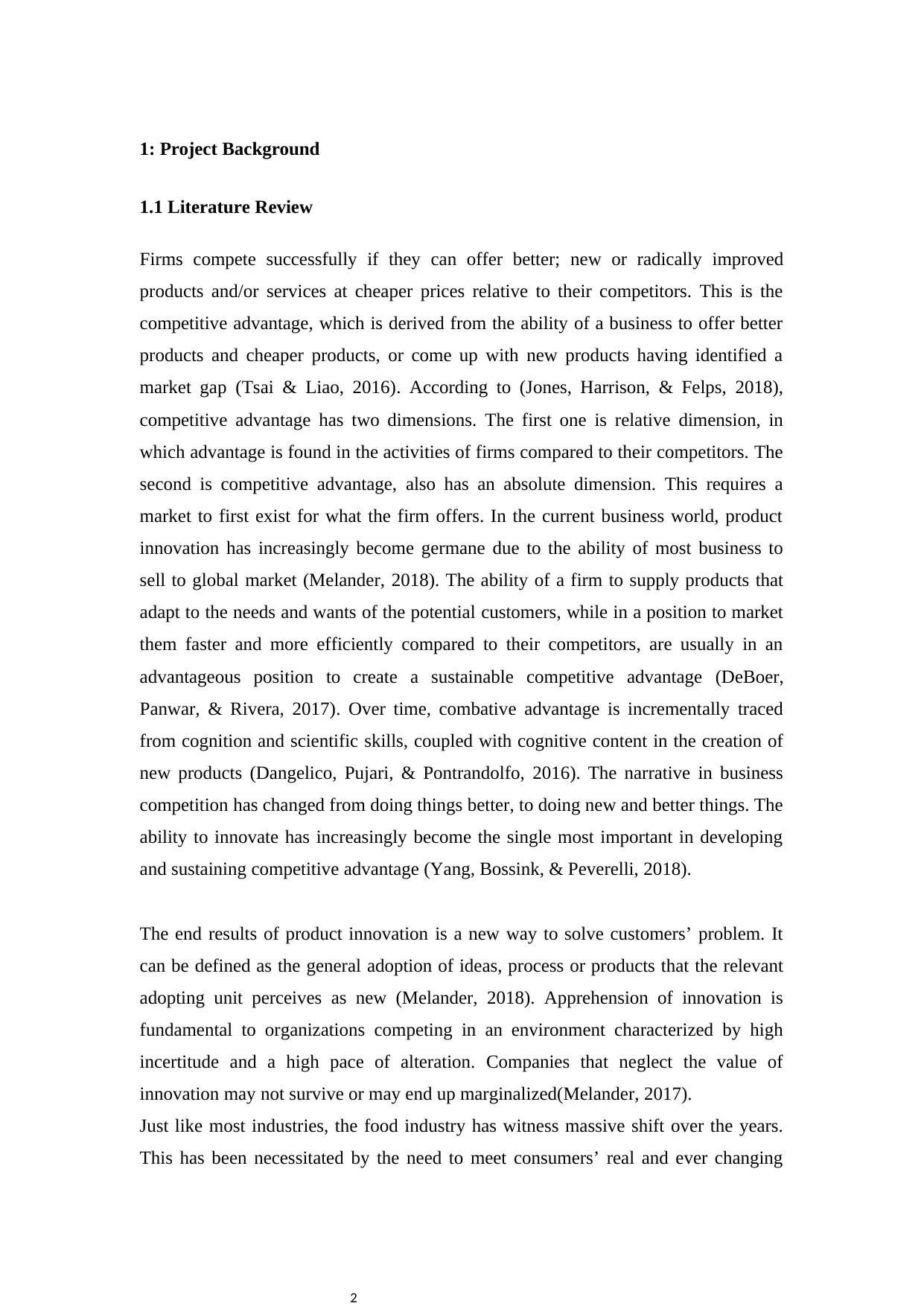
2
1: Project Background
1.1 Literature Review
Firms compete successfully if they can offer better; new or radically improved
products and/or services at cheaper prices relative to their competitors. This is the
competitive advantage, which is derived from the ability of a business to offer better
products and cheaper products, or come up with new products having identified a
market gap (Tsai & Liao, 2016). According to (Jones, Harrison, & Felps, 2018),
competitive advantage has two dimensions. The first one is relative dimension, in
which advantage is found in the activities of firms compared to their competitors. The
second is competitive advantage, also has an absolute dimension. This requires a
market to first exist for what the firm offers. In the current business world, product
innovation has increasingly become germane due to the ability of most business to
sell to global market (Melander, 2018). The ability of a firm to supply products that
adapt to the needs and wants of the potential customers, while in a position to market
them faster and more efficiently compared to their competitors, are usually in an
advantageous position to create a sustainable competitive advantage (DeBoer,
Panwar, & Rivera, 2017). Over time, combative advantage is incrementally traced
from cognition and scientific skills, coupled with cognitive content in the creation of
new products (Dangelico, Pujari, & Pontrandolfo, 2016). The narrative in business
competition has changed from doing things better, to doing new and better things. The
ability to innovate has increasingly become the single most important in developing
and sustaining competitive advantage (Yang, Bossink, & Peverelli, 2018).
The end results of product innovation is a new way to solve customers’ problem. It
can be defined as the general adoption of ideas, process or products that the relevant
adopting unit perceives as new (Melander, 2018). Apprehension of innovation is
fundamental to organizations competing in an environment characterized by high
incertitude and a high pace of alteration. Companies that neglect the value of
innovation may not survive or may end up marginalized(Melander, 2017).
Just like most industries, the food industry has witness massive shift over the years.
This has been necessitated by the need to meet consumers’ real and ever changing
1: Project Background
1.1 Literature Review
Firms compete successfully if they can offer better; new or radically improved
products and/or services at cheaper prices relative to their competitors. This is the
competitive advantage, which is derived from the ability of a business to offer better
products and cheaper products, or come up with new products having identified a
market gap (Tsai & Liao, 2016). According to (Jones, Harrison, & Felps, 2018),
competitive advantage has two dimensions. The first one is relative dimension, in
which advantage is found in the activities of firms compared to their competitors. The
second is competitive advantage, also has an absolute dimension. This requires a
market to first exist for what the firm offers. In the current business world, product
innovation has increasingly become germane due to the ability of most business to
sell to global market (Melander, 2018). The ability of a firm to supply products that
adapt to the needs and wants of the potential customers, while in a position to market
them faster and more efficiently compared to their competitors, are usually in an
advantageous position to create a sustainable competitive advantage (DeBoer,
Panwar, & Rivera, 2017). Over time, combative advantage is incrementally traced
from cognition and scientific skills, coupled with cognitive content in the creation of
new products (Dangelico, Pujari, & Pontrandolfo, 2016). The narrative in business
competition has changed from doing things better, to doing new and better things. The
ability to innovate has increasingly become the single most important in developing
and sustaining competitive advantage (Yang, Bossink, & Peverelli, 2018).
The end results of product innovation is a new way to solve customers’ problem. It
can be defined as the general adoption of ideas, process or products that the relevant
adopting unit perceives as new (Melander, 2018). Apprehension of innovation is
fundamental to organizations competing in an environment characterized by high
incertitude and a high pace of alteration. Companies that neglect the value of
innovation may not survive or may end up marginalized(Melander, 2017).
Just like most industries, the food industry has witness massive shift over the years.
This has been necessitated by the need to meet consumers’ real and ever changing
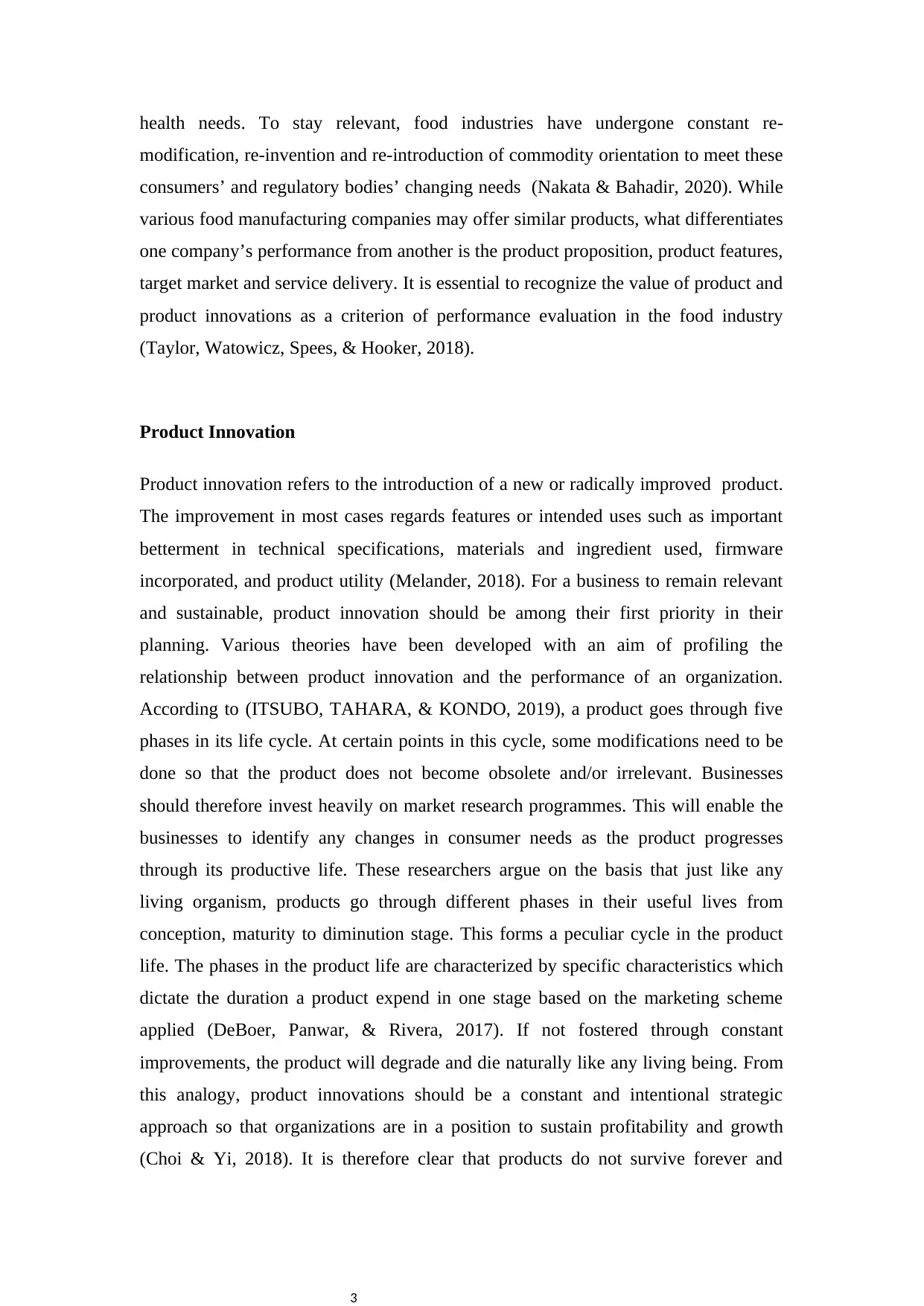
3
health needs. To stay relevant, food industries have undergone constant re-
modification, re-invention and re-introduction of commodity orientation to meet these
consumers’ and regulatory bodies’ changing needs (Nakata & Bahadir, 2020). While
various food manufacturing companies may offer similar products, what differentiates
one company’s performance from another is the product proposition, product features,
target market and service delivery. It is essential to recognize the value of product and
product innovations as a criterion of performance evaluation in the food industry
(Taylor, Watowicz, Spees, & Hooker, 2018).
Product Innovation
Product innovation refers to the introduction of a new or radically improved product.
The improvement in most cases regards features or intended uses such as important
betterment in technical specifications, materials and ingredient used, firmware
incorporated, and product utility (Melander, 2018). For a business to remain relevant
and sustainable, product innovation should be among their first priority in their
planning. Various theories have been developed with an aim of profiling the
relationship between product innovation and the performance of an organization.
According to (ITSUBO, TAHARA, & KONDO, 2019), a product goes through five
phases in its life cycle. At certain points in this cycle, some modifications need to be
done so that the product does not become obsolete and/or irrelevant. Businesses
should therefore invest heavily on market research programmes. This will enable the
businesses to identify any changes in consumer needs as the product progresses
through its productive life. These researchers argue on the basis that just like any
living organism, products go through different phases in their useful lives from
conception, maturity to diminution stage. This forms a peculiar cycle in the product
life. The phases in the product life are characterized by specific characteristics which
dictate the duration a product expend in one stage based on the marketing scheme
applied (DeBoer, Panwar, & Rivera, 2017). If not fostered through constant
improvements, the product will degrade and die naturally like any living being. From
this analogy, product innovations should be a constant and intentional strategic
approach so that organizations are in a position to sustain profitability and growth
(Choi & Yi, 2018). It is therefore clear that products do not survive forever and
health needs. To stay relevant, food industries have undergone constant re-
modification, re-invention and re-introduction of commodity orientation to meet these
consumers’ and regulatory bodies’ changing needs (Nakata & Bahadir, 2020). While
various food manufacturing companies may offer similar products, what differentiates
one company’s performance from another is the product proposition, product features,
target market and service delivery. It is essential to recognize the value of product and
product innovations as a criterion of performance evaluation in the food industry
(Taylor, Watowicz, Spees, & Hooker, 2018).
Product Innovation
Product innovation refers to the introduction of a new or radically improved product.
The improvement in most cases regards features or intended uses such as important
betterment in technical specifications, materials and ingredient used, firmware
incorporated, and product utility (Melander, 2018). For a business to remain relevant
and sustainable, product innovation should be among their first priority in their
planning. Various theories have been developed with an aim of profiling the
relationship between product innovation and the performance of an organization.
According to (ITSUBO, TAHARA, & KONDO, 2019), a product goes through five
phases in its life cycle. At certain points in this cycle, some modifications need to be
done so that the product does not become obsolete and/or irrelevant. Businesses
should therefore invest heavily on market research programmes. This will enable the
businesses to identify any changes in consumer needs as the product progresses
through its productive life. These researchers argue on the basis that just like any
living organism, products go through different phases in their useful lives from
conception, maturity to diminution stage. This forms a peculiar cycle in the product
life. The phases in the product life are characterized by specific characteristics which
dictate the duration a product expend in one stage based on the marketing scheme
applied (DeBoer, Panwar, & Rivera, 2017). If not fostered through constant
improvements, the product will degrade and die naturally like any living being. From
this analogy, product innovations should be a constant and intentional strategic
approach so that organizations are in a position to sustain profitability and growth
(Choi & Yi, 2018). It is therefore clear that products do not survive forever and
⊘ This is a preview!⊘
Do you want full access?
Subscribe today to unlock all pages.

Trusted by 1+ million students worldwide
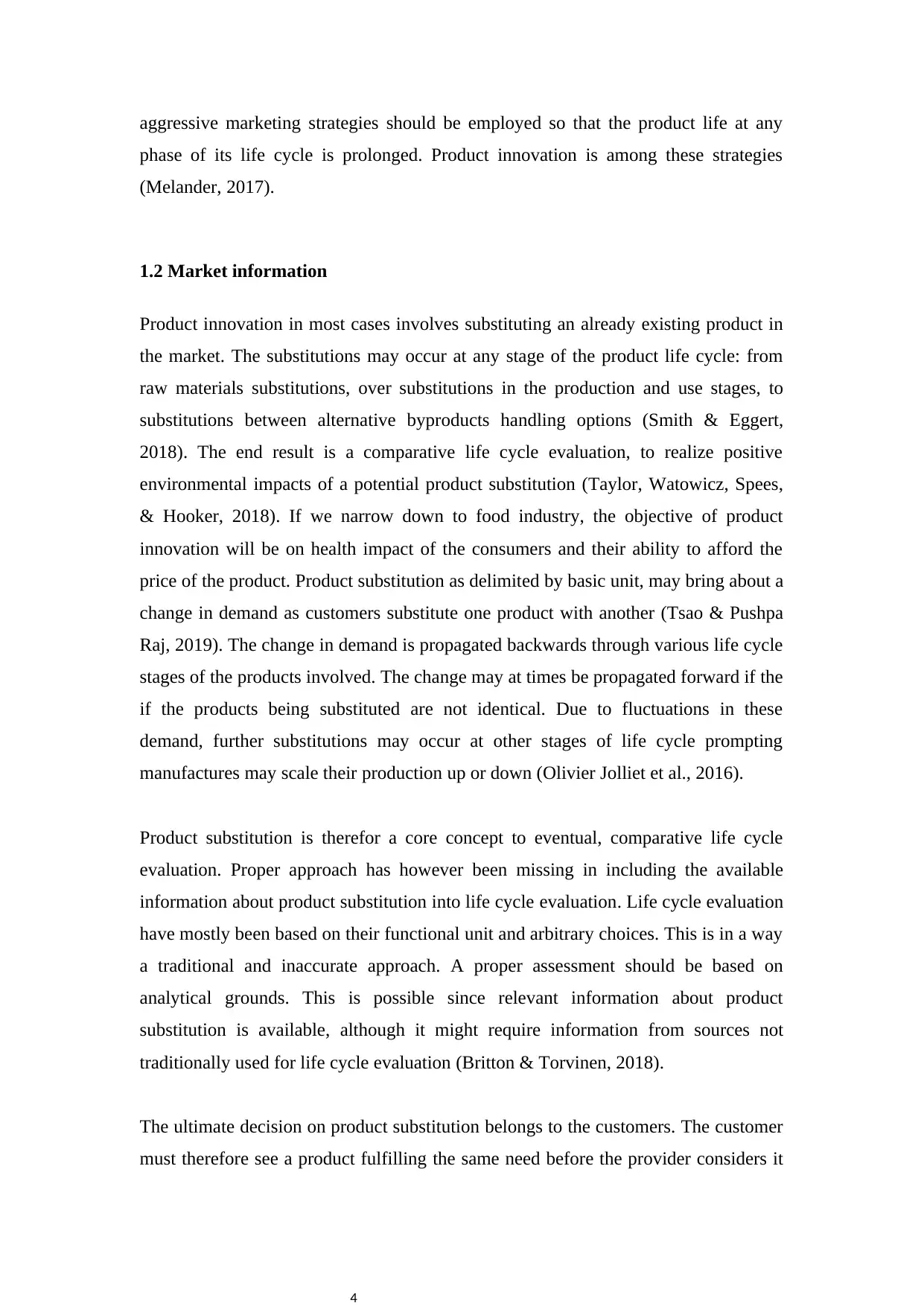
4
aggressive marketing strategies should be employed so that the product life at any
phase of its life cycle is prolonged. Product innovation is among these strategies
(Melander, 2017).
1.2 Market information
Product innovation in most cases involves substituting an already existing product in
the market. The substitutions may occur at any stage of the product life cycle: from
raw materials substitutions, over substitutions in the production and use stages, to
substitutions between alternative byproducts handling options (Smith & Eggert,
2018). The end result is a comparative life cycle evaluation, to realize positive
environmental impacts of a potential product substitution (Taylor, Watowicz, Spees,
& Hooker, 2018). If we narrow down to food industry, the objective of product
innovation will be on health impact of the consumers and their ability to afford the
price of the product. Product substitution as delimited by basic unit, may bring about a
change in demand as customers substitute one product with another (Tsao & Pushpa
Raj, 2019). The change in demand is propagated backwards through various life cycle
stages of the products involved. The change may at times be propagated forward if the
if the products being substituted are not identical. Due to fluctuations in these
demand, further substitutions may occur at other stages of life cycle prompting
manufactures may scale their production up or down (Olivier Jolliet et al., 2016).
Product substitution is therefor a core concept to eventual, comparative life cycle
evaluation. Proper approach has however been missing in including the available
information about product substitution into life cycle evaluation. Life cycle evaluation
have mostly been based on their functional unit and arbitrary choices. This is in a way
a traditional and inaccurate approach. A proper assessment should be based on
analytical grounds. This is possible since relevant information about product
substitution is available, although it might require information from sources not
traditionally used for life cycle evaluation (Britton & Torvinen, 2018).
The ultimate decision on product substitution belongs to the customers. The customer
must therefore see a product fulfilling the same need before the provider considers it
aggressive marketing strategies should be employed so that the product life at any
phase of its life cycle is prolonged. Product innovation is among these strategies
(Melander, 2017).
1.2 Market information
Product innovation in most cases involves substituting an already existing product in
the market. The substitutions may occur at any stage of the product life cycle: from
raw materials substitutions, over substitutions in the production and use stages, to
substitutions between alternative byproducts handling options (Smith & Eggert,
2018). The end result is a comparative life cycle evaluation, to realize positive
environmental impacts of a potential product substitution (Taylor, Watowicz, Spees,
& Hooker, 2018). If we narrow down to food industry, the objective of product
innovation will be on health impact of the consumers and their ability to afford the
price of the product. Product substitution as delimited by basic unit, may bring about a
change in demand as customers substitute one product with another (Tsao & Pushpa
Raj, 2019). The change in demand is propagated backwards through various life cycle
stages of the products involved. The change may at times be propagated forward if the
if the products being substituted are not identical. Due to fluctuations in these
demand, further substitutions may occur at other stages of life cycle prompting
manufactures may scale their production up or down (Olivier Jolliet et al., 2016).
Product substitution is therefor a core concept to eventual, comparative life cycle
evaluation. Proper approach has however been missing in including the available
information about product substitution into life cycle evaluation. Life cycle evaluation
have mostly been based on their functional unit and arbitrary choices. This is in a way
a traditional and inaccurate approach. A proper assessment should be based on
analytical grounds. This is possible since relevant information about product
substitution is available, although it might require information from sources not
traditionally used for life cycle evaluation (Britton & Torvinen, 2018).
The ultimate decision on product substitution belongs to the customers. The customer
must therefore see a product fulfilling the same need before the provider considers it
Paraphrase This Document
Need a fresh take? Get an instant paraphrase of this document with our AI Paraphraser
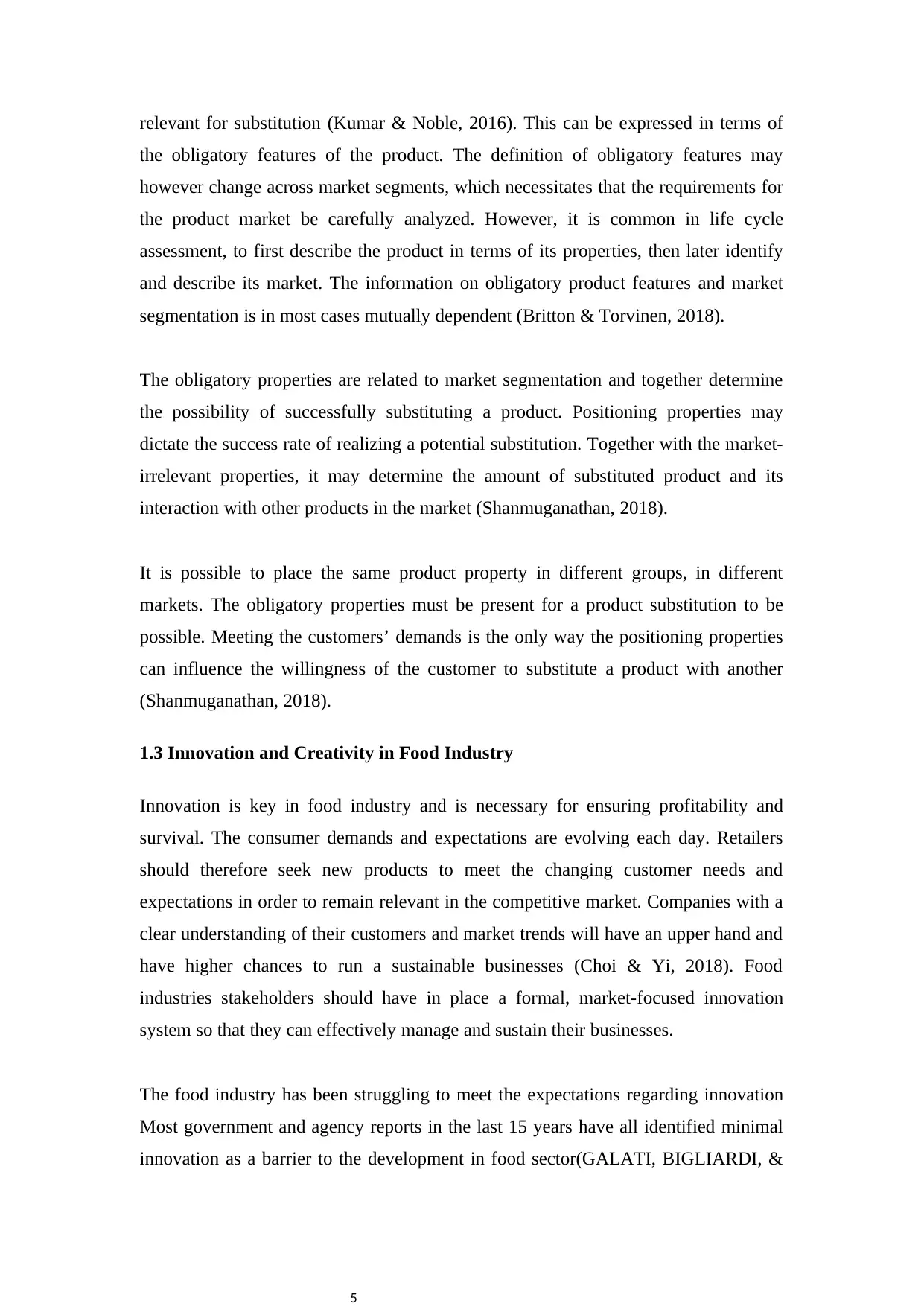
5
relevant for substitution (Kumar & Noble, 2016). This can be expressed in terms of
the obligatory features of the product. The definition of obligatory features may
however change across market segments, which necessitates that the requirements for
the product market be carefully analyzed. However, it is common in life cycle
assessment, to first describe the product in terms of its properties, then later identify
and describe its market. The information on obligatory product features and market
segmentation is in most cases mutually dependent (Britton & Torvinen, 2018).
The obligatory properties are related to market segmentation and together determine
the possibility of successfully substituting a product. Positioning properties may
dictate the success rate of realizing a potential substitution. Together with the market-
irrelevant properties, it may determine the amount of substituted product and its
interaction with other products in the market (Shanmuganathan, 2018).
It is possible to place the same product property in different groups, in different
markets. The obligatory properties must be present for a product substitution to be
possible. Meeting the customers’ demands is the only way the positioning properties
can influence the willingness of the customer to substitute a product with another
(Shanmuganathan, 2018).
1.3 Innovation and Creativity in Food Industry
Innovation is key in food industry and is necessary for ensuring profitability and
survival. The consumer demands and expectations are evolving each day. Retailers
should therefore seek new products to meet the changing customer needs and
expectations in order to remain relevant in the competitive market. Companies with a
clear understanding of their customers and market trends will have an upper hand and
have higher chances to run a sustainable businesses (Choi & Yi, 2018). Food
industries stakeholders should have in place a formal, market-focused innovation
system so that they can effectively manage and sustain their businesses.
The food industry has been struggling to meet the expectations regarding innovation
Most government and agency reports in the last 15 years have all identified minimal
innovation as a barrier to the development in food sector(GALATI, BIGLIARDI, &
relevant for substitution (Kumar & Noble, 2016). This can be expressed in terms of
the obligatory features of the product. The definition of obligatory features may
however change across market segments, which necessitates that the requirements for
the product market be carefully analyzed. However, it is common in life cycle
assessment, to first describe the product in terms of its properties, then later identify
and describe its market. The information on obligatory product features and market
segmentation is in most cases mutually dependent (Britton & Torvinen, 2018).
The obligatory properties are related to market segmentation and together determine
the possibility of successfully substituting a product. Positioning properties may
dictate the success rate of realizing a potential substitution. Together with the market-
irrelevant properties, it may determine the amount of substituted product and its
interaction with other products in the market (Shanmuganathan, 2018).
It is possible to place the same product property in different groups, in different
markets. The obligatory properties must be present for a product substitution to be
possible. Meeting the customers’ demands is the only way the positioning properties
can influence the willingness of the customer to substitute a product with another
(Shanmuganathan, 2018).
1.3 Innovation and Creativity in Food Industry
Innovation is key in food industry and is necessary for ensuring profitability and
survival. The consumer demands and expectations are evolving each day. Retailers
should therefore seek new products to meet the changing customer needs and
expectations in order to remain relevant in the competitive market. Companies with a
clear understanding of their customers and market trends will have an upper hand and
have higher chances to run a sustainable businesses (Choi & Yi, 2018). Food
industries stakeholders should have in place a formal, market-focused innovation
system so that they can effectively manage and sustain their businesses.
The food industry has been struggling to meet the expectations regarding innovation
Most government and agency reports in the last 15 years have all identified minimal
innovation as a barrier to the development in food sector(GALATI, BIGLIARDI, &
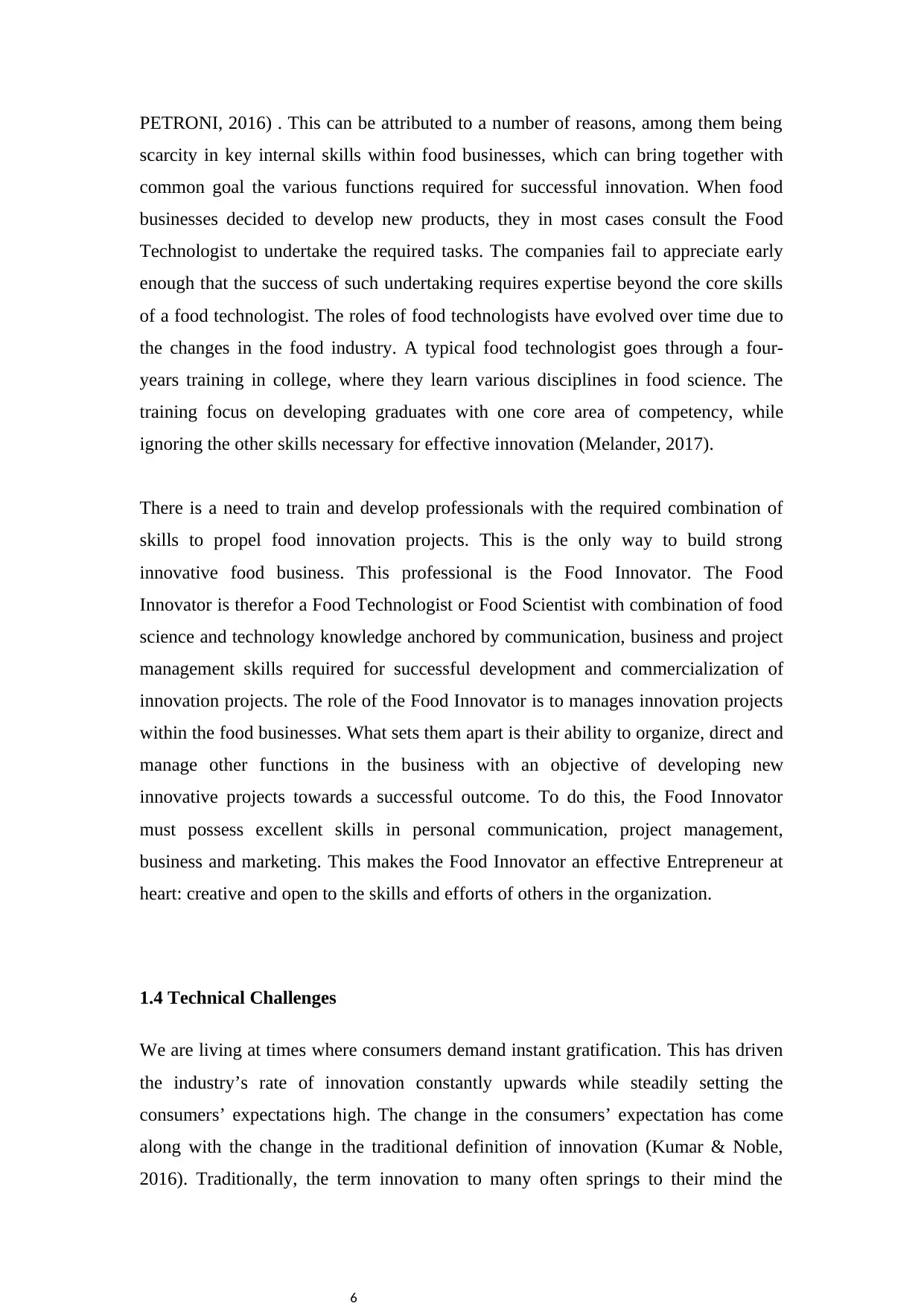
6
PETRONI, 2016) . This can be attributed to a number of reasons, among them being
scarcity in key internal skills within food businesses, which can bring together with
common goal the various functions required for successful innovation. When food
businesses decided to develop new products, they in most cases consult the Food
Technologist to undertake the required tasks. The companies fail to appreciate early
enough that the success of such undertaking requires expertise beyond the core skills
of a food technologist. The roles of food technologists have evolved over time due to
the changes in the food industry. A typical food technologist goes through a four-
years training in college, where they learn various disciplines in food science. The
training focus on developing graduates with one core area of competency, while
ignoring the other skills necessary for effective innovation (Melander, 2017).
There is a need to train and develop professionals with the required combination of
skills to propel food innovation projects. This is the only way to build strong
innovative food business. This professional is the Food Innovator. The Food
Innovator is therefor a Food Technologist or Food Scientist with combination of food
science and technology knowledge anchored by communication, business and project
management skills required for successful development and commercialization of
innovation projects. The role of the Food Innovator is to manages innovation projects
within the food businesses. What sets them apart is their ability to organize, direct and
manage other functions in the business with an objective of developing new
innovative projects towards a successful outcome. To do this, the Food Innovator
must possess excellent skills in personal communication, project management,
business and marketing. This makes the Food Innovator an effective Entrepreneur at
heart: creative and open to the skills and efforts of others in the organization.
1.4 Technical Challenges
We are living at times where consumers demand instant gratification. This has driven
the industry’s rate of innovation constantly upwards while steadily setting the
consumers’ expectations high. The change in the consumers’ expectation has come
along with the change in the traditional definition of innovation (Kumar & Noble,
2016). Traditionally, the term innovation to many often springs to their mind the
PETRONI, 2016) . This can be attributed to a number of reasons, among them being
scarcity in key internal skills within food businesses, which can bring together with
common goal the various functions required for successful innovation. When food
businesses decided to develop new products, they in most cases consult the Food
Technologist to undertake the required tasks. The companies fail to appreciate early
enough that the success of such undertaking requires expertise beyond the core skills
of a food technologist. The roles of food technologists have evolved over time due to
the changes in the food industry. A typical food technologist goes through a four-
years training in college, where they learn various disciplines in food science. The
training focus on developing graduates with one core area of competency, while
ignoring the other skills necessary for effective innovation (Melander, 2017).
There is a need to train and develop professionals with the required combination of
skills to propel food innovation projects. This is the only way to build strong
innovative food business. This professional is the Food Innovator. The Food
Innovator is therefor a Food Technologist or Food Scientist with combination of food
science and technology knowledge anchored by communication, business and project
management skills required for successful development and commercialization of
innovation projects. The role of the Food Innovator is to manages innovation projects
within the food businesses. What sets them apart is their ability to organize, direct and
manage other functions in the business with an objective of developing new
innovative projects towards a successful outcome. To do this, the Food Innovator
must possess excellent skills in personal communication, project management,
business and marketing. This makes the Food Innovator an effective Entrepreneur at
heart: creative and open to the skills and efforts of others in the organization.
1.4 Technical Challenges
We are living at times where consumers demand instant gratification. This has driven
the industry’s rate of innovation constantly upwards while steadily setting the
consumers’ expectations high. The change in the consumers’ expectation has come
along with the change in the traditional definition of innovation (Kumar & Noble,
2016). Traditionally, the term innovation to many often springs to their mind the
⊘ This is a preview!⊘
Do you want full access?
Subscribe today to unlock all pages.

Trusted by 1+ million students worldwide
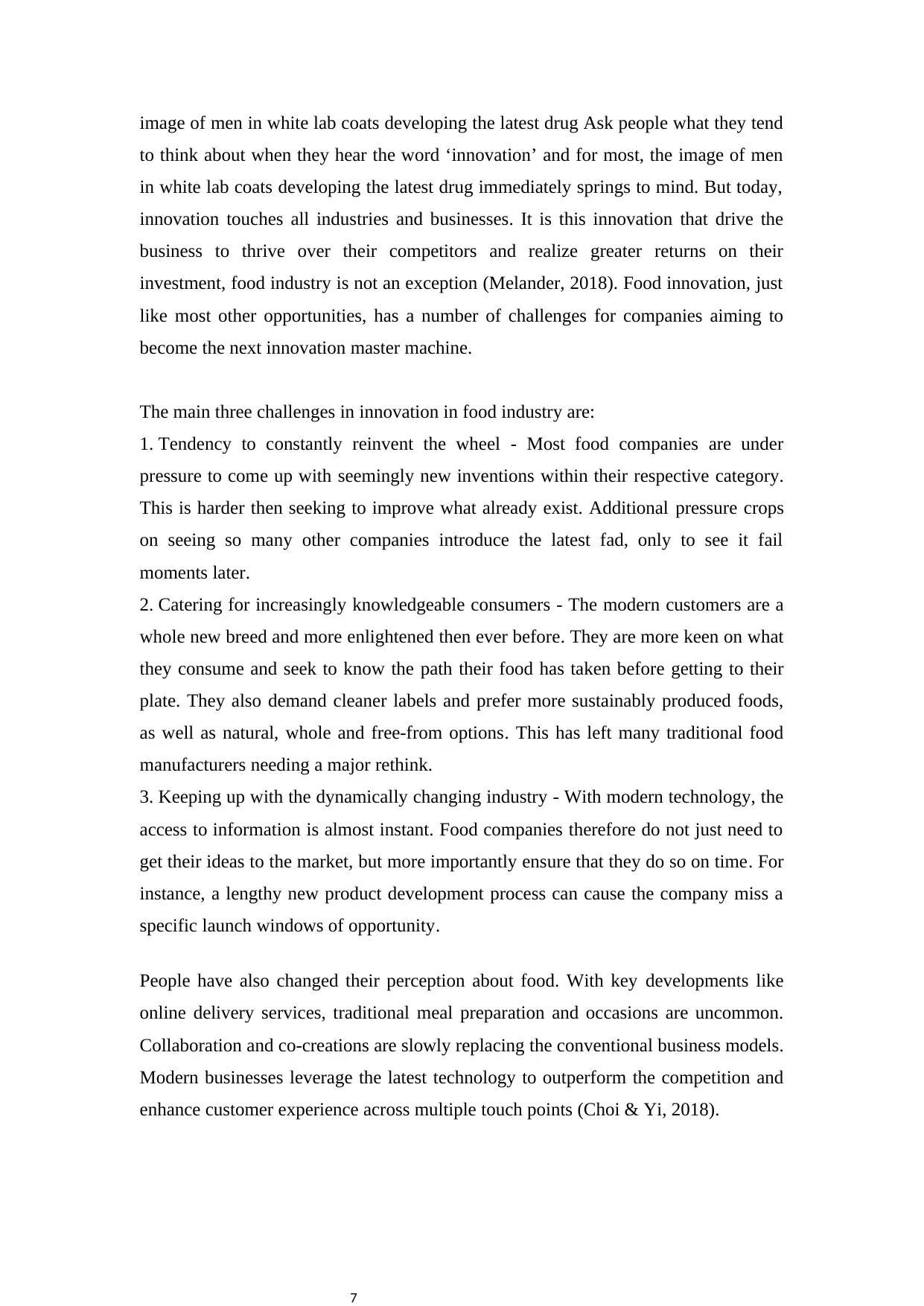
7
image of men in white lab coats developing the latest drug Ask people what they tend
to think about when they hear the word ‘innovation’ and for most, the image of men
in white lab coats developing the latest drug immediately springs to mind. But today,
innovation touches all industries and businesses. It is this innovation that drive the
business to thrive over their competitors and realize greater returns on their
investment, food industry is not an exception (Melander, 2018). Food innovation, just
like most other opportunities, has a number of challenges for companies aiming to
become the next innovation master machine.
The main three challenges in innovation in food industry are:
1. Tendency to constantly reinvent the wheel - Most food companies are under
pressure to come up with seemingly new inventions within their respective category.
This is harder then seeking to improve what already exist. Additional pressure crops
on seeing so many other companies introduce the latest fad, only to see it fail
moments later.
2. Catering for increasingly knowledgeable consumers - The modern customers are a
whole new breed and more enlightened then ever before. They are more keen on what
they consume and seek to know the path their food has taken before getting to their
plate. They also demand cleaner labels and prefer more sustainably produced foods,
as well as natural, whole and free-from options. This has left many traditional food
manufacturers needing a major rethink.
3. Keeping up with the dynamically changing industry - With modern technology, the
access to information is almost instant. Food companies therefore do not just need to
get their ideas to the market, but more importantly ensure that they do so on time. For
instance, a lengthy new product development process can cause the company miss a
specific launch windows of opportunity.
People have also changed their perception about food. With key developments like
online delivery services, traditional meal preparation and occasions are uncommon.
Collaboration and co-creations are slowly replacing the conventional business models.
Modern businesses leverage the latest technology to outperform the competition and
enhance customer experience across multiple touch points (Choi & Yi, 2018).
image of men in white lab coats developing the latest drug Ask people what they tend
to think about when they hear the word ‘innovation’ and for most, the image of men
in white lab coats developing the latest drug immediately springs to mind. But today,
innovation touches all industries and businesses. It is this innovation that drive the
business to thrive over their competitors and realize greater returns on their
investment, food industry is not an exception (Melander, 2018). Food innovation, just
like most other opportunities, has a number of challenges for companies aiming to
become the next innovation master machine.
The main three challenges in innovation in food industry are:
1. Tendency to constantly reinvent the wheel - Most food companies are under
pressure to come up with seemingly new inventions within their respective category.
This is harder then seeking to improve what already exist. Additional pressure crops
on seeing so many other companies introduce the latest fad, only to see it fail
moments later.
2. Catering for increasingly knowledgeable consumers - The modern customers are a
whole new breed and more enlightened then ever before. They are more keen on what
they consume and seek to know the path their food has taken before getting to their
plate. They also demand cleaner labels and prefer more sustainably produced foods,
as well as natural, whole and free-from options. This has left many traditional food
manufacturers needing a major rethink.
3. Keeping up with the dynamically changing industry - With modern technology, the
access to information is almost instant. Food companies therefore do not just need to
get their ideas to the market, but more importantly ensure that they do so on time. For
instance, a lengthy new product development process can cause the company miss a
specific launch windows of opportunity.
People have also changed their perception about food. With key developments like
online delivery services, traditional meal preparation and occasions are uncommon.
Collaboration and co-creations are slowly replacing the conventional business models.
Modern businesses leverage the latest technology to outperform the competition and
enhance customer experience across multiple touch points (Choi & Yi, 2018).
Paraphrase This Document
Need a fresh take? Get an instant paraphrase of this document with our AI Paraphraser
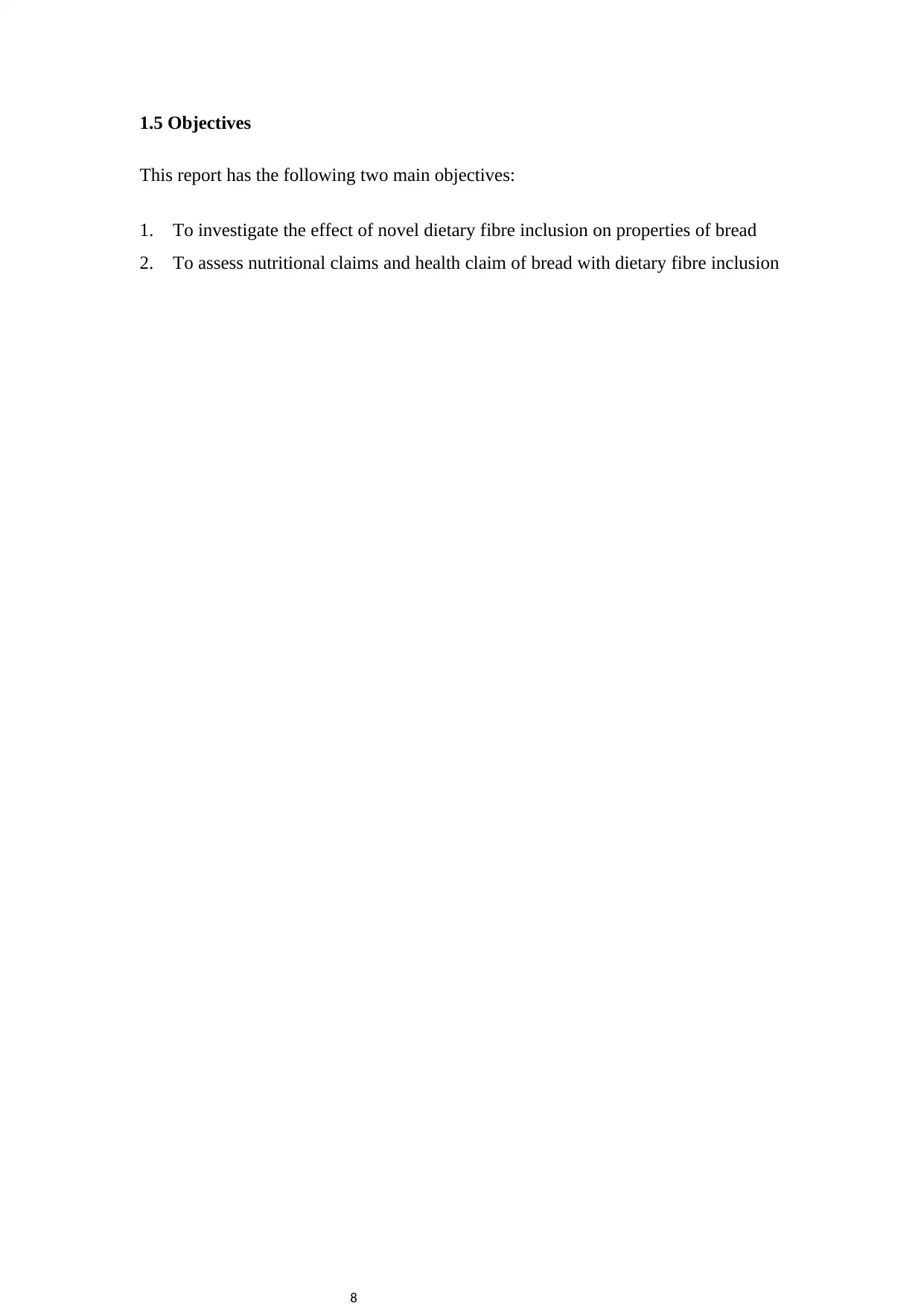
8
1.5 Objectives
This report has the following two main objectives:
1. To investigate the effect of novel dietary fibre inclusion on properties of bread
2. To assess nutritional claims and health claim of bread with dietary fibre inclusion
1.5 Objectives
This report has the following two main objectives:
1. To investigate the effect of novel dietary fibre inclusion on properties of bread
2. To assess nutritional claims and health claim of bread with dietary fibre inclusion
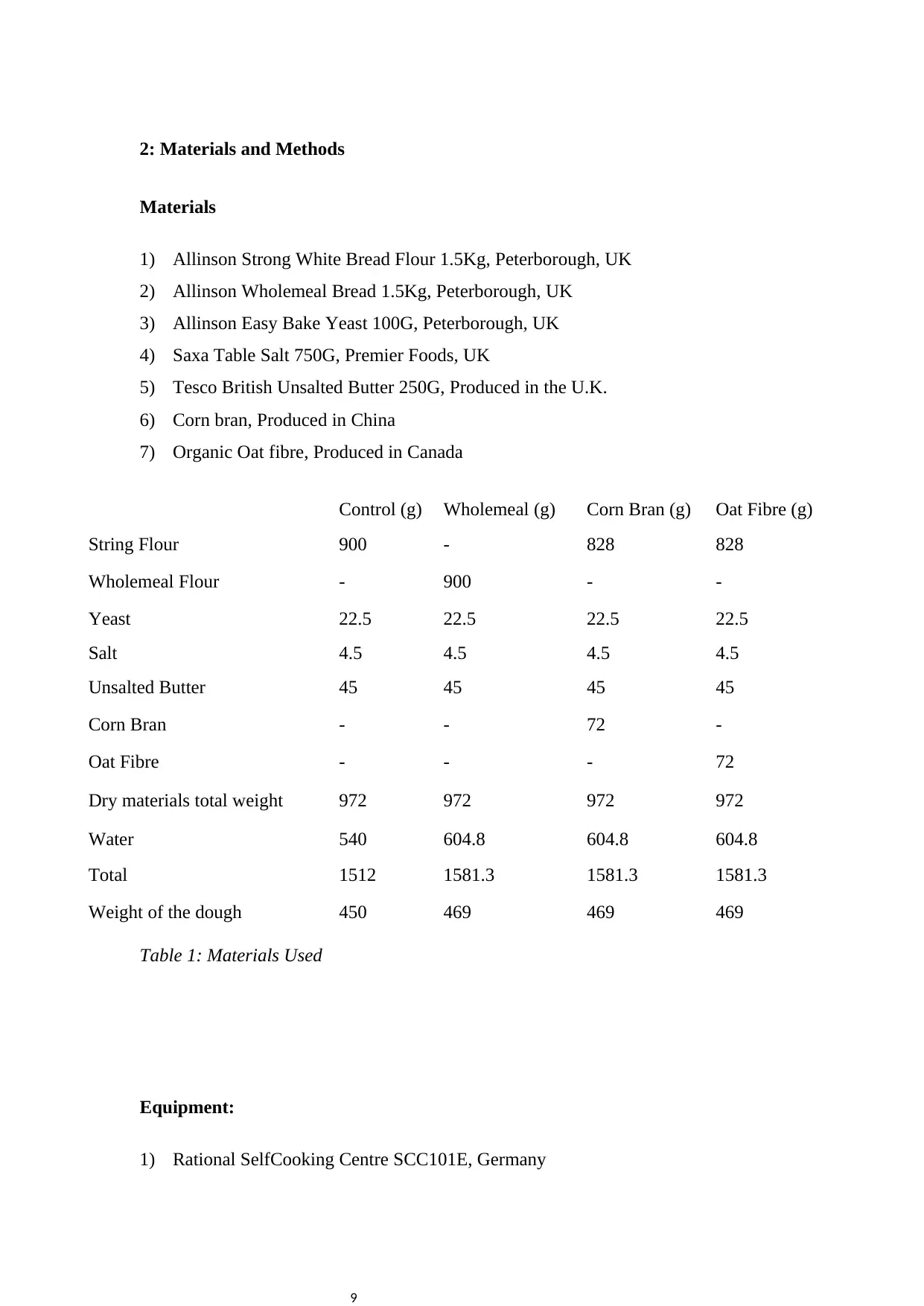
9
2: Materials and Methods
Materials
1) Allinson Strong White Bread Flour 1.5Kg, Peterborough, UK
2) Allinson Wholemeal Bread 1.5Kg, Peterborough, UK
3) Allinson Easy Bake Yeast 100G, Peterborough, UK
4) Saxa Table Salt 750G, Premier Foods, UK
5) Tesco British Unsalted Butter 250G, Produced in the U.K.
6) Corn bran, Produced in China
7) Organic Oat fibre, Produced in Canada
Control (g) Wholemeal (g) Corn Bran (g) Oat Fibre (g)
String Flour 900 - 828 828
Wholemeal Flour - 900 - -
Yeast 22.5 22.5 22.5 22.5
Salt 4.5 4.5 4.5 4.5
Unsalted Butter 45 45 45 45
Corn Bran - - 72 -
Oat Fibre - - - 72
Dry materials total weight 972 972 972 972
Water 540 604.8 604.8 604.8
Total 1512 1581.3 1581.3 1581.3
Weight of the dough 450 469 469 469
Table 1: Materials Used
Equipment:
1) Rational SelfCooking Centre SCC101E, Germany
2: Materials and Methods
Materials
1) Allinson Strong White Bread Flour 1.5Kg, Peterborough, UK
2) Allinson Wholemeal Bread 1.5Kg, Peterborough, UK
3) Allinson Easy Bake Yeast 100G, Peterborough, UK
4) Saxa Table Salt 750G, Premier Foods, UK
5) Tesco British Unsalted Butter 250G, Produced in the U.K.
6) Corn bran, Produced in China
7) Organic Oat fibre, Produced in Canada
Control (g) Wholemeal (g) Corn Bran (g) Oat Fibre (g)
String Flour 900 - 828 828
Wholemeal Flour - 900 - -
Yeast 22.5 22.5 22.5 22.5
Salt 4.5 4.5 4.5 4.5
Unsalted Butter 45 45 45 45
Corn Bran - - 72 -
Oat Fibre - - - 72
Dry materials total weight 972 972 972 972
Water 540 604.8 604.8 604.8
Total 1512 1581.3 1581.3 1581.3
Weight of the dough 450 469 469 469
Table 1: Materials Used
Equipment:
1) Rational SelfCooking Centre SCC101E, Germany
⊘ This is a preview!⊘
Do you want full access?
Subscribe today to unlock all pages.

Trusted by 1+ million students worldwide
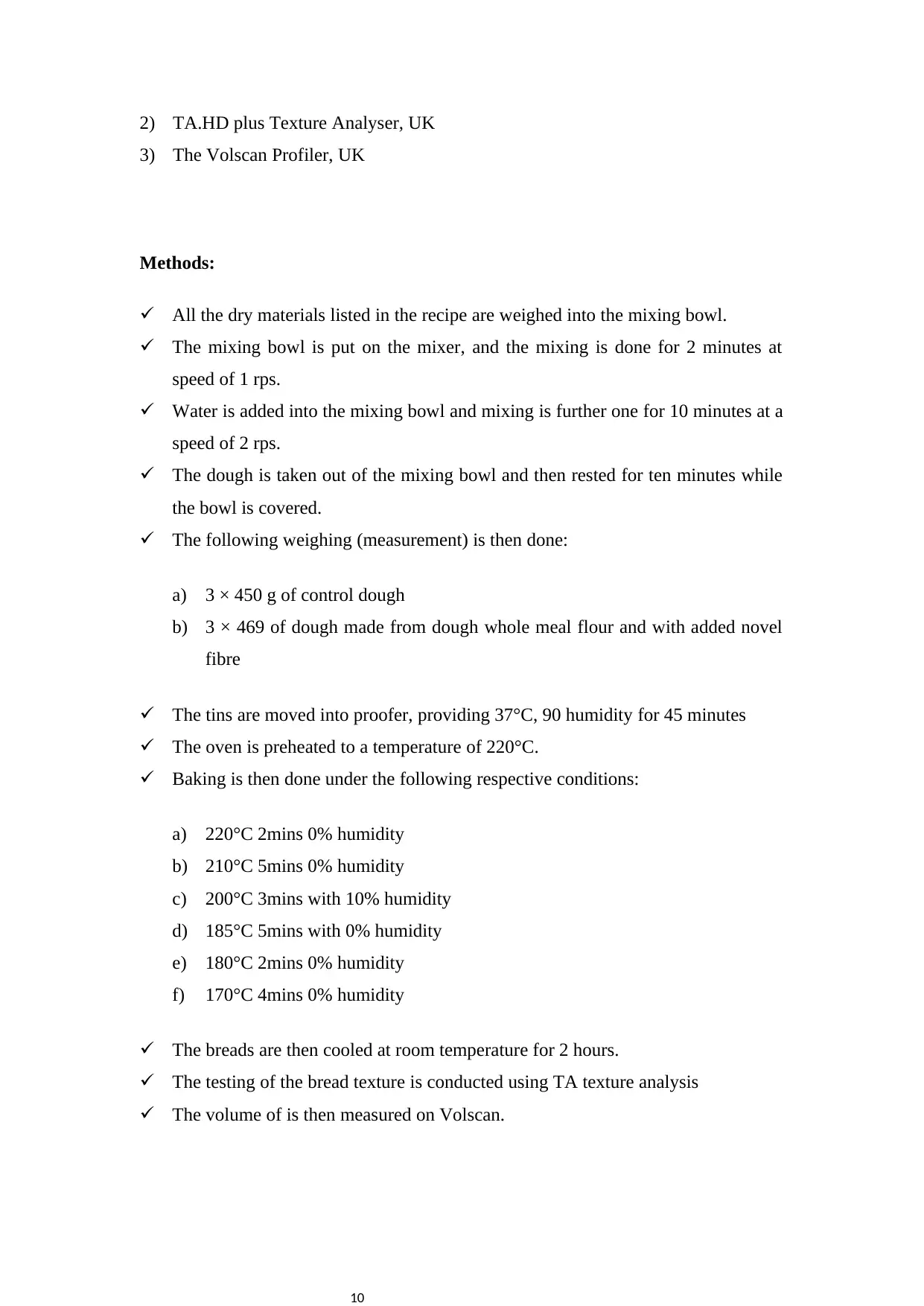
10
2) TA.HD plus Texture Analyser, UK
3) The Volscan Profiler, UK
Methods:
All the dry materials listed in the recipe are weighed into the mixing bowl.
The mixing bowl is put on the mixer, and the mixing is done for 2 minutes at
speed of 1 rps.
Water is added into the mixing bowl and mixing is further one for 10 minutes at a
speed of 2 rps.
The dough is taken out of the mixing bowl and then rested for ten minutes while
the bowl is covered.
The following weighing (measurement) is then done:
a) 3 × 450 g of control dough
b) 3 × 469 of dough made from dough whole meal flour and with added novel
fibre
The tins are moved into proofer, providing 37°C, 90 humidity for 45 minutes
The oven is preheated to a temperature of 220°C.
Baking is then done under the following respective conditions:
a) 220°C 2mins 0% humidity
b) 210°C 5mins 0% humidity
c) 200°C 3mins with 10% humidity
d) 185°C 5mins with 0% humidity
e) 180°C 2mins 0% humidity
f) 170°C 4mins 0% humidity
The breads are then cooled at room temperature for 2 hours.
The testing of the bread texture is conducted using TA texture analysis
The volume of is then measured on Volscan.
2) TA.HD plus Texture Analyser, UK
3) The Volscan Profiler, UK
Methods:
All the dry materials listed in the recipe are weighed into the mixing bowl.
The mixing bowl is put on the mixer, and the mixing is done for 2 minutes at
speed of 1 rps.
Water is added into the mixing bowl and mixing is further one for 10 minutes at a
speed of 2 rps.
The dough is taken out of the mixing bowl and then rested for ten minutes while
the bowl is covered.
The following weighing (measurement) is then done:
a) 3 × 450 g of control dough
b) 3 × 469 of dough made from dough whole meal flour and with added novel
fibre
The tins are moved into proofer, providing 37°C, 90 humidity for 45 minutes
The oven is preheated to a temperature of 220°C.
Baking is then done under the following respective conditions:
a) 220°C 2mins 0% humidity
b) 210°C 5mins 0% humidity
c) 200°C 3mins with 10% humidity
d) 185°C 5mins with 0% humidity
e) 180°C 2mins 0% humidity
f) 170°C 4mins 0% humidity
The breads are then cooled at room temperature for 2 hours.
The testing of the bread texture is conducted using TA texture analysis
The volume of is then measured on Volscan.
Paraphrase This Document
Need a fresh take? Get an instant paraphrase of this document with our AI Paraphraser
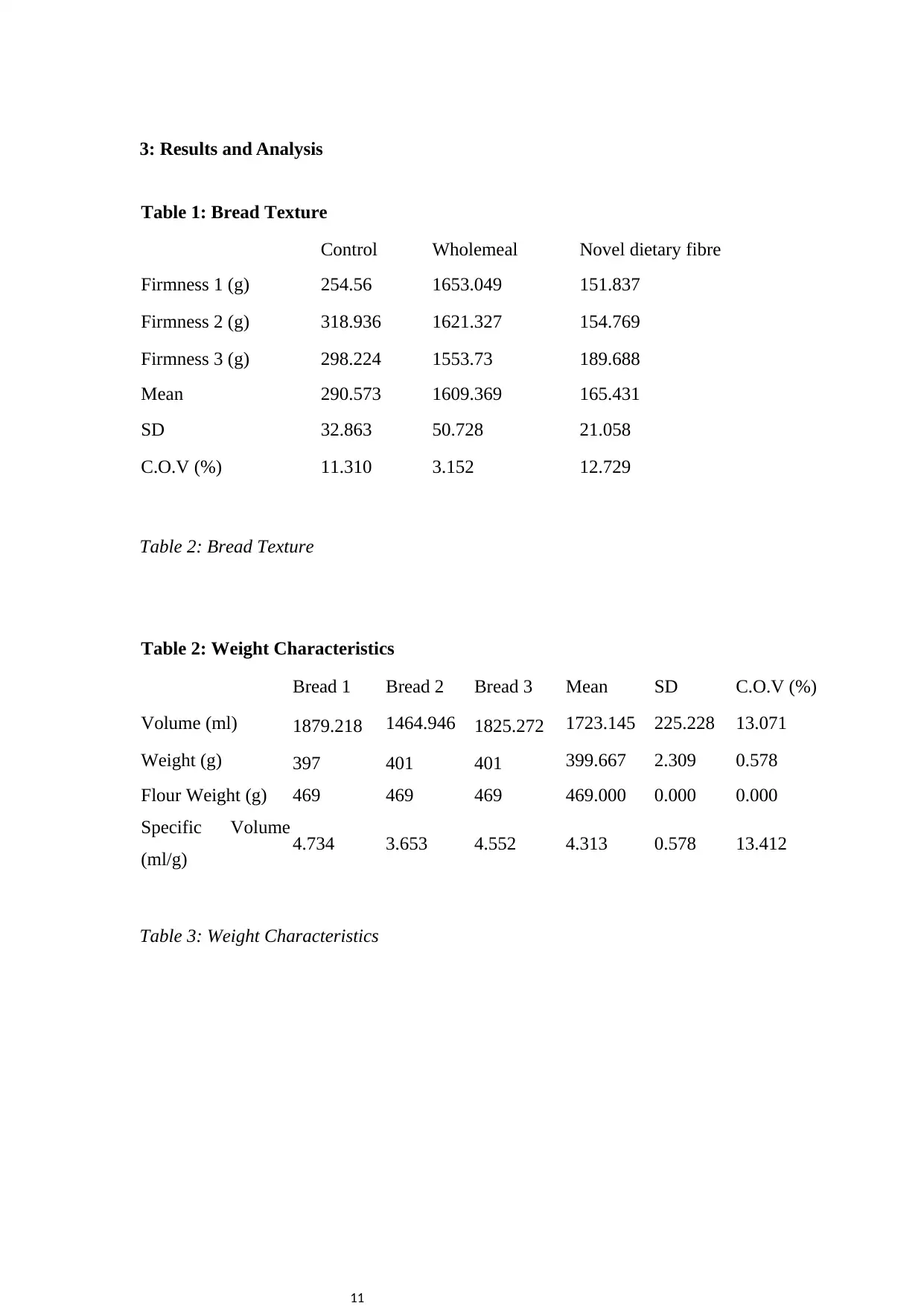
11
3: Results and Analysis
Table 1: Bread Texture
Control Wholemeal Novel dietary fibre
Firmness 1 (g) 254.56 1653.049 151.837
Firmness 2 (g) 318.936 1621.327 154.769
Firmness 3 (g) 298.224 1553.73 189.688
Mean 290.573 1609.369 165.431
SD 32.863 50.728 21.058
C.O.V (%) 11.310 3.152 12.729
Table 2: Bread Texture
Table 2: Weight Characteristics
Bread 1 Bread 2 Bread 3 Mean SD C.O.V (%)
Volume (ml) 1879.218 1464.946 1825.272 1723.145 225.228 13.071
Weight (g) 397 401 401 399.667 2.309 0.578
Flour Weight (g) 469 469 469 469.000 0.000 0.000
Specific Volume
(ml/g) 4.734 3.653 4.552 4.313 0.578 13.412
Table 3: Weight Characteristics
3: Results and Analysis
Table 1: Bread Texture
Control Wholemeal Novel dietary fibre
Firmness 1 (g) 254.56 1653.049 151.837
Firmness 2 (g) 318.936 1621.327 154.769
Firmness 3 (g) 298.224 1553.73 189.688
Mean 290.573 1609.369 165.431
SD 32.863 50.728 21.058
C.O.V (%) 11.310 3.152 12.729
Table 2: Bread Texture
Table 2: Weight Characteristics
Bread 1 Bread 2 Bread 3 Mean SD C.O.V (%)
Volume (ml) 1879.218 1464.946 1825.272 1723.145 225.228 13.071
Weight (g) 397 401 401 399.667 2.309 0.578
Flour Weight (g) 469 469 469 469.000 0.000 0.000
Specific Volume
(ml/g) 4.734 3.653 4.552 4.313 0.578 13.412
Table 3: Weight Characteristics
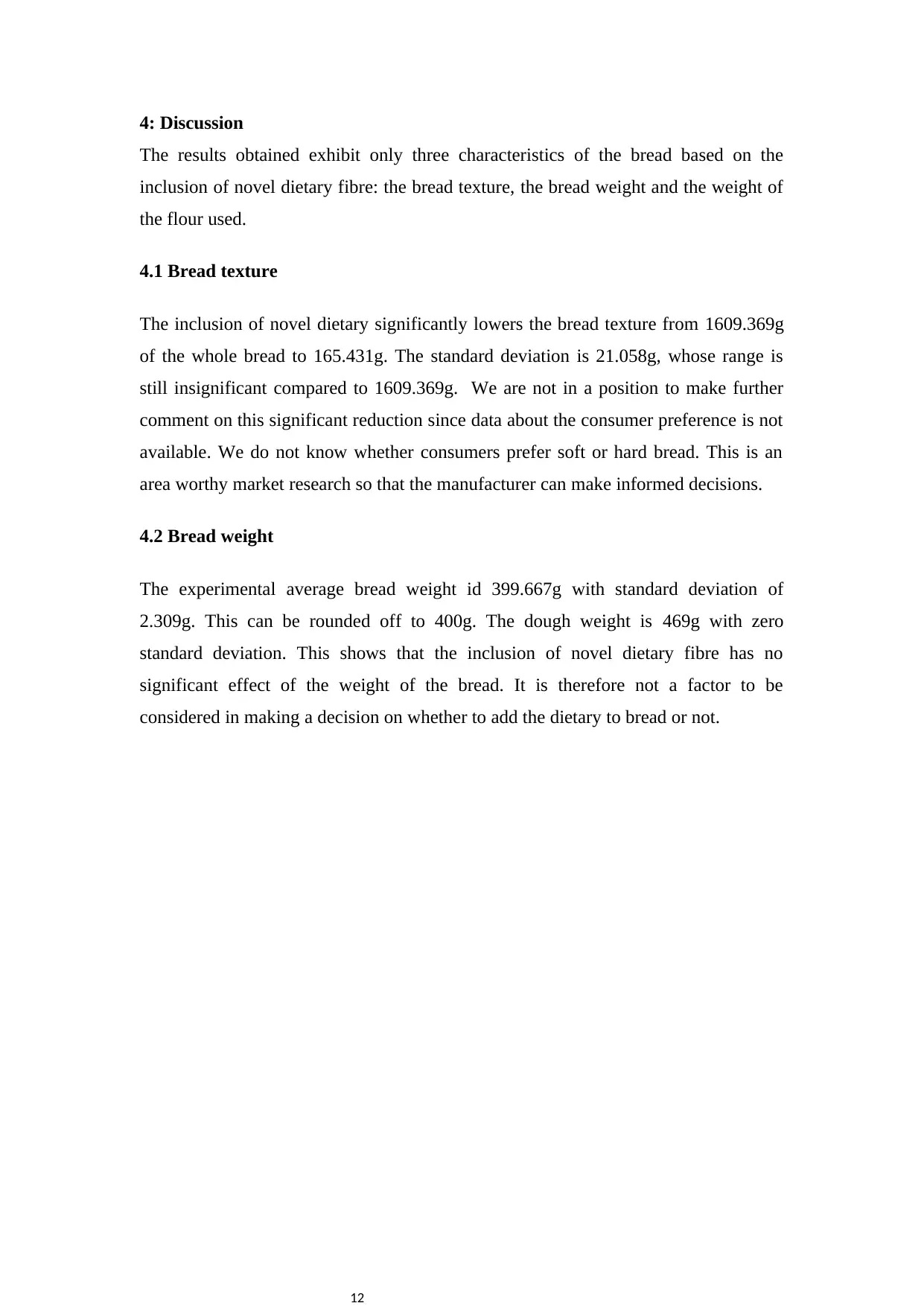
12
4: Discussion
The results obtained exhibit only three characteristics of the bread based on the
inclusion of novel dietary fibre: the bread texture, the bread weight and the weight of
the flour used.
4.1 Bread texture
The inclusion of novel dietary significantly lowers the bread texture from 1609.369g
of the whole bread to 165.431g. The standard deviation is 21.058g, whose range is
still insignificant compared to 1609.369g. We are not in a position to make further
comment on this significant reduction since data about the consumer preference is not
available. We do not know whether consumers prefer soft or hard bread. This is an
area worthy market research so that the manufacturer can make informed decisions.
4.2 Bread weight
The experimental average bread weight id 399.667g with standard deviation of
2.309g. This can be rounded off to 400g. The dough weight is 469g with zero
standard deviation. This shows that the inclusion of novel dietary fibre has no
significant effect of the weight of the bread. It is therefore not a factor to be
considered in making a decision on whether to add the dietary to bread or not.
4: Discussion
The results obtained exhibit only three characteristics of the bread based on the
inclusion of novel dietary fibre: the bread texture, the bread weight and the weight of
the flour used.
4.1 Bread texture
The inclusion of novel dietary significantly lowers the bread texture from 1609.369g
of the whole bread to 165.431g. The standard deviation is 21.058g, whose range is
still insignificant compared to 1609.369g. We are not in a position to make further
comment on this significant reduction since data about the consumer preference is not
available. We do not know whether consumers prefer soft or hard bread. This is an
area worthy market research so that the manufacturer can make informed decisions.
4.2 Bread weight
The experimental average bread weight id 399.667g with standard deviation of
2.309g. This can be rounded off to 400g. The dough weight is 469g with zero
standard deviation. This shows that the inclusion of novel dietary fibre has no
significant effect of the weight of the bread. It is therefore not a factor to be
considered in making a decision on whether to add the dietary to bread or not.
⊘ This is a preview!⊘
Do you want full access?
Subscribe today to unlock all pages.

Trusted by 1+ million students worldwide
1 out of 15
Related Documents
Your All-in-One AI-Powered Toolkit for Academic Success.
+13062052269
info@desklib.com
Available 24*7 on WhatsApp / Email
![[object Object]](/_next/static/media/star-bottom.7253800d.svg)
Unlock your academic potential
Copyright © 2020–2025 A2Z Services. All Rights Reserved. Developed and managed by ZUCOL.




